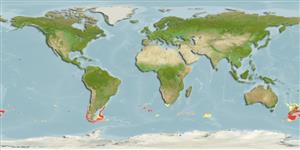>
Pleuronectiformes (Flatfishes) >
Achiropsettidae (Southern flounders)
Etymology: Neoachiropsetta: Greek, neos = new + Greek, a = without + Greek, chei = hands + Greek, psetta = grouper (Ref. 45335).
Environment: milieu / climate zone / depth range / distribution range
Ökologie
seewasser bathydemersal; tiefenbereich 165 - 1012 m (Ref. 119562). Deep-water
Southwest Pacific: southern New Zealand. Southeast Pacific: off southern Chile. Southwest Atlantic: Argentina, the Falkland Islands (Ref. 4417) and the Burdwood Bank. Southeast Atlantic: Discovery Seamount, off Cape Town (South Africa). Antarctic Indian Ocean: Prince Edward and the Crozet Islands.
Size / Gewicht / Alter
Maturity: Lm ? range ? - ? cm
Max length : 57.0 cm SL Männchen/unbestimmt; (Ref. 5000)
Rückenflossenstacheln (insgesamt): 0; Rückenflossenweichstrahlen (insgesamt): 117-139; Afterflossenstacheln 0; Afterflossenweichstrahlen: 104 - 124; Wirbelzahl: 62 - 66. Brownish grey; median fins darker; pelvic fin on eyed side with 7 rays, on blind side 6-7 rays (Ref. 4417).
Life cycle and mating behavior
Geschlechtsreife | Fortpflanzung | Ablaichen | Eier | Fecundity | Larven
Heemstra, P.C., 1990. Achiropsettidae. p. 408-413. In O. Gon and P.C. Heemstra (eds.) Fishes of the Southern Ocean. J.L.B. Smith Institute of Ichthyology, Grahamstown, South Africa. (Ref. 5000)
IUCN Rote Liste Status (Ref. 130435)
Bedrohung für Menschen
Harmless
Nutzung durch Menschen
Mehr Information
NamenSynonymeMetabolismusRäuberÖkotoxikologieFortpflanzungGeschlechtsreifeAblaichenSpawning aggregationFecundityEierEientwicklung
ReferenzenAquakulturAquakultur ProfilZuchtlinienGenetikElectrophoresesVererbbarkeitKrankheitenVerarbeitungNutrientsMass conversion
Tools
Zusatzinformationen
Download XML
Internet Quellen
Estimates based on models
Preferred temperature (Ref.
123201): 2.3 - 11, mean 7 °C (based on 240 cells).
Phylogenetic diversity index (Ref.
82804): PD
50 = 1.0625 [Uniqueness, from 0.5 = low to 2.0 = high].
Bayesian length-weight: a=0.01995 (0.00906 - 0.04395), b=3.01 (2.83 - 3.19), in cm total length, based on all LWR estimates for this body shape (Ref.
93245).
Trophic level (Ref.
69278): 3.9 ±0.62 se; based on food items.
Fishing Vulnerability (Ref.
59153): Moderate to high vulnerability (48 of 100).
